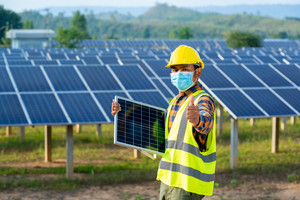Demystifying Neutral Ground Bonding in Solar Power Systems with EG4 Inverters
Posted by Robert Goldsmith on 1st Mar 2023
If you're interested in building a PV solar system using EG4 inverters, it's important to understand neutral ground bonding. This guide will help you achieve code compliance while ensuring your solar power system is safe and reliable. In this article, we'll provide a comprehensive guide to neutral ground bonding in different scenarios and explain how to use EG4 inverters to achieve optimal results.
What is Neutral Ground Bonding?
Neutral ground bonding is a crucial issue when building a solar power system. It refers to the connection of the neutral wire to the ground wire in the AC circuit. Proper neutral ground bonding is necessary to ensure safety and comply with code requirements.
Off-Grid Neutral Ground Bonding
Let’s start with a typical standalone system. If you're building a system without a grid source or service panel for the AC input side, you will need to ensure that your inverter output has a disconnect source. Therefore, your bond will need to be at your main breaker-style output panel.
Any generator connected to your inverter (excluding the use of a ChargeVerter) would need to have no bond or use a 3-pole transfer switch to keep a continuous neutral. All inverters shipped since November 2022 have the bond screw removed to make this easy, so if your unit has the original black terminals, you will likely need to remove the bonding screw inside.
Grid-Connected Neutral Ground Bonding
Now let’s look at a power system that is using the grid as a backup source of power. The inverter would supply power whenever it can and transfer to the grid for occasional support automatically.
Normally, your inverter is passing through the utility neutral and the bond from your main panel is passed alongside, but when your grid goes down, the inverter’s built-in neutral relay disconnects the utility neutral to create its own. This is where the default internal bond screw would normally be applicable to create a bond since you no longer have access to the grid bond.
The concern with this arises when you’re operating in inverter mode with multiple inverters, as now you will have two or more bonds on the same ground which could cause an objectionable current. This would be in violation of NEC 250.6, so the answer would seem to be just to take out the screw entirely, but you would have an unbonded system while in inverter only mode.
EG4 has removed this bond screw and configured the inverter’s relay using software to always pass through the neutral to match US industry standards for stationary systems. This way, you will always have the grid’s neutral bond passed through and have the bond on the output panel as well. This applies to units shipped after February of ‘23 and beyond as well as any firmware update with version 61.13 or later on the 6000w unit or 79.63 on the 6500w unit.
If you have inverters installed with grid connection, we recommend ensuring that you have the latest firmware and that there are no ground bonds on the output side of the inverter.
Mobile Application Neutral Ground Bonding
Finally, we'll look at a mobile build, like a typical RV or 5th wheel that may occasionally connect to shore power to recharge batteries or power air conditioning. When the mobile build is not connected to shore power, it typically relies on batteries or a generator to power the electrical components. In this case, a neutral ground bonding plug is not necessary as the RV or 5th wheel's built-in electrical system should already be designed to handle any potential electrical imbalances.
However, if you do connect your mobile build to shore power, it is important to make sure that you follow the correct neutral ground bonding procedures to ensure your safety and avoid any damage to your electrical components. You should always use a portable or fixed ground fault circuit interrupter (GFCI) outlet when connecting to shore power. A GFCI outlet monitors the flow of electricity and will shut off the power if it detects any imbalances, which can be caused by faulty wiring or damaged electrical equipment.
Additionally, when connecting to shore power, you should always make sure that the ground conductor is properly connected to the ground terminal of the power supply, and that the neutral conductor is properly connected to the neutral terminal of the power supply. This will ensure that any electrical imbalances are safely redirected to the ground, protecting you and your mobile build.
Contact Us for Continued Support
To achieve optimal results with EG4 inverters, it's recommended that you have the latest firmware updates. For example, any firmware update with version 61.13 or later on the 6000w unit or 79.63 on the 6500w unit will provide you with the latest software features and bug fixes, ensuring that your system is running smoothly.
In conclusion, neutral ground bonding is a crucial aspect of solar power systems, and it's essential to achieve code compliance while ensuring the safety and reliability of the system. Whether you're using EG4 inverters or not, it's important to follow the guidelines and recommendations provided by the manufacturer to achieve optimal results. By understanding the different scenarios and following the details outlined in this guide, you can achieve code compliance and ensure your system is safe and reliable.
Additionally, if you still want a better understanding of neutral ground bonding, we've included a video below. Check it out and join Brayden as he guides you through a detailed explanation of how it all works, and how it can affect you. If you have any questions or need further assistance, please don't hesitate to contact us.

